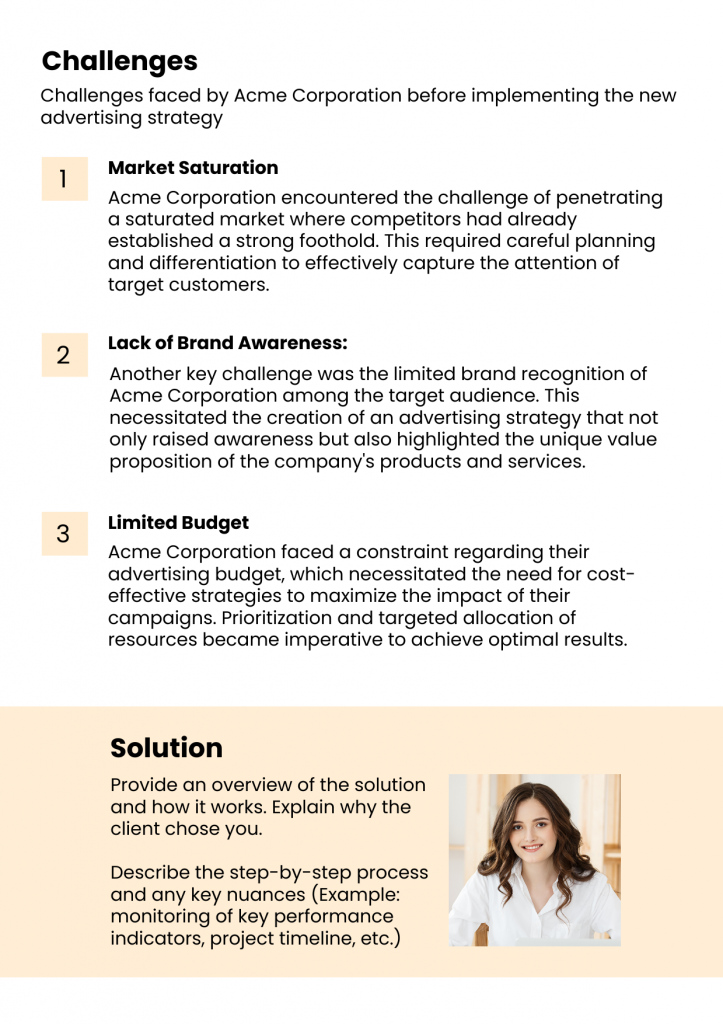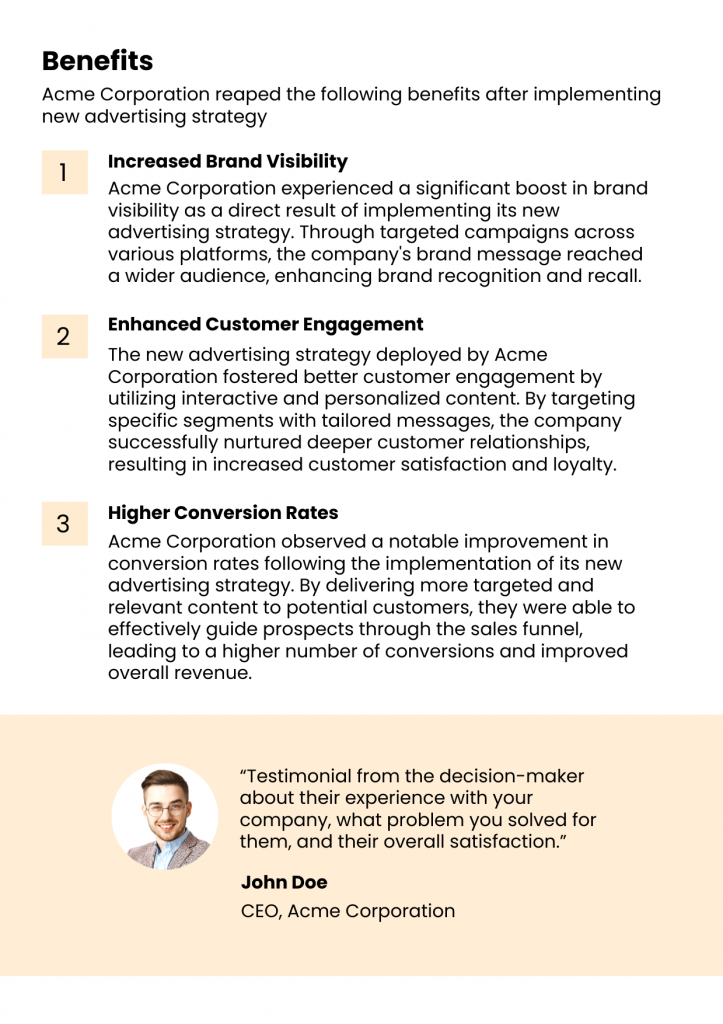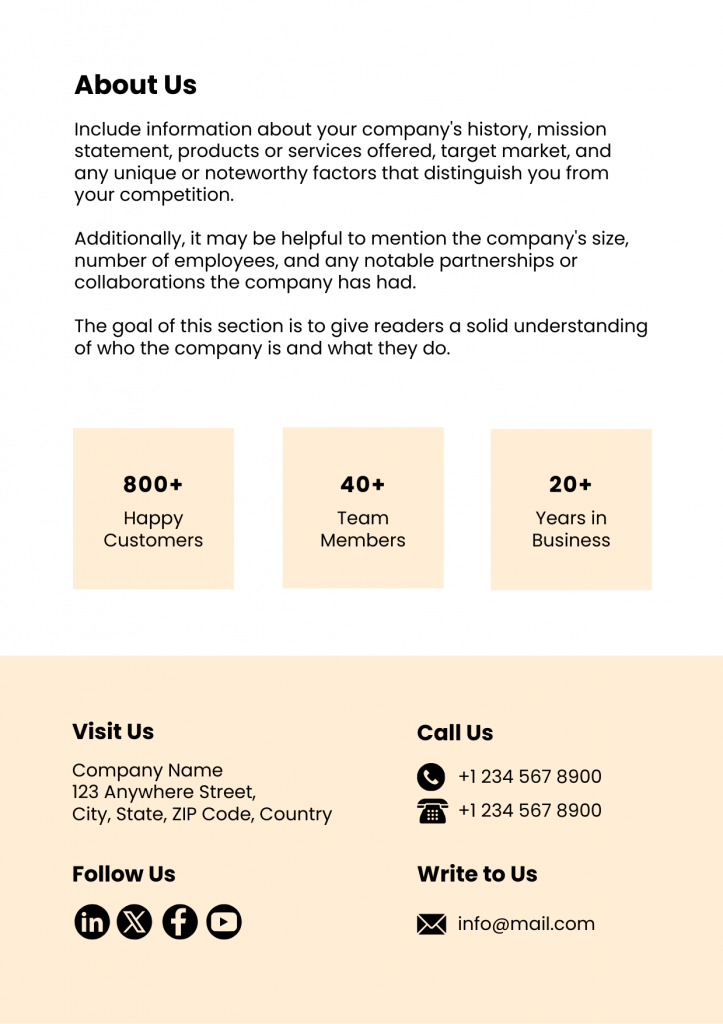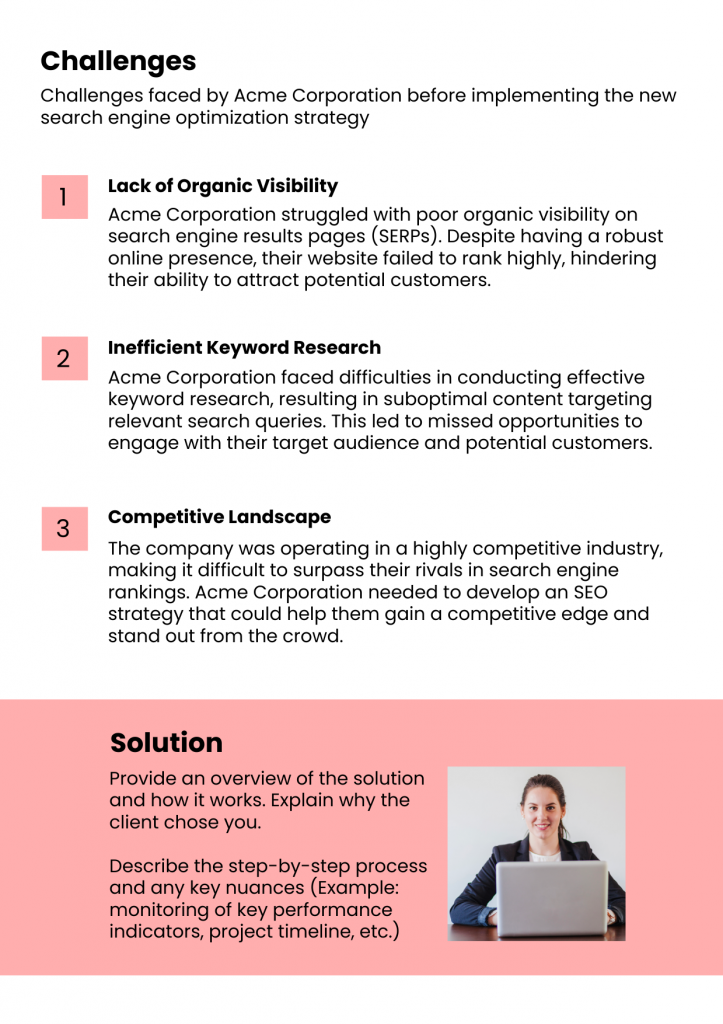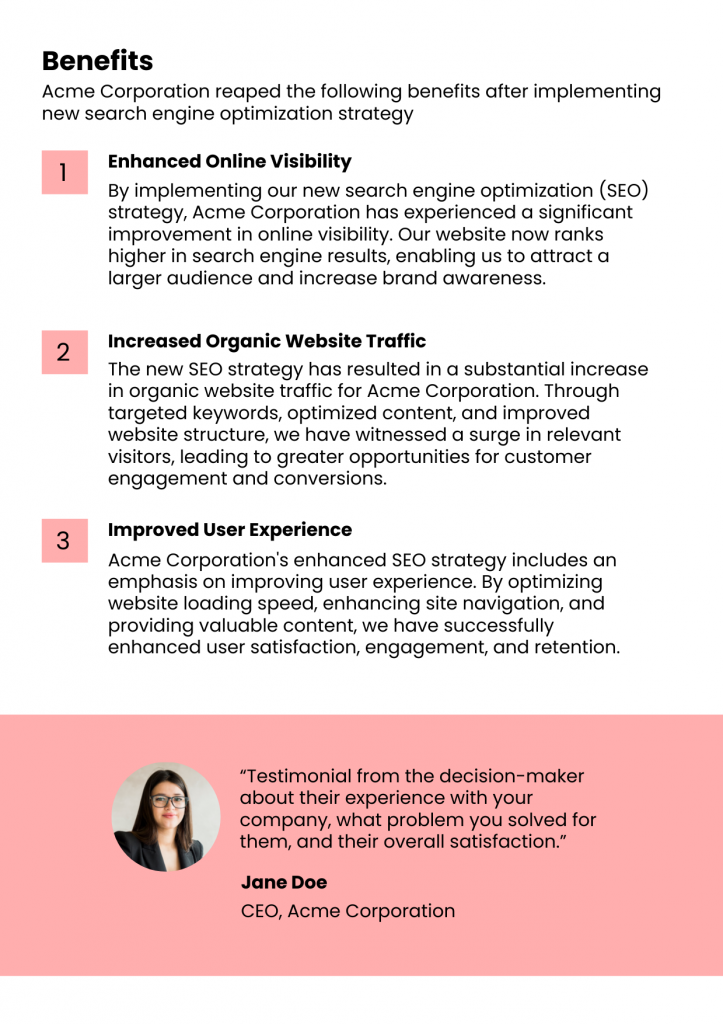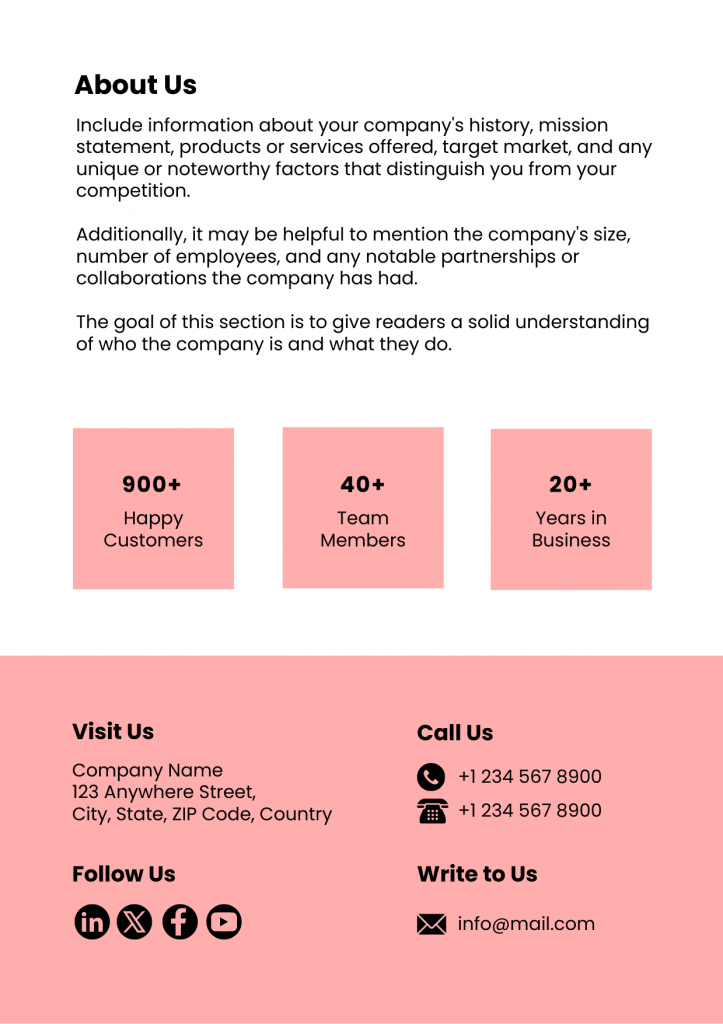
How to Write a Case Study: A Complete Guide with Templates

Writing compelling and insightful case studies is a marketer’s biggest job, yet most get frustrated with this content. The challenge? Figuring out how to write a case study that not only highlights the company’s strongest suit but engages new clients with strategic information. If you often struggle with making case studies as more than just dry facts and figures, you’re leading your efforts to missed opportunities.
How to Write a Case Study Step-by-Step
- Craft a Compelling Headline: Highlight the main success with a clear, direct title.
- Start with a Strong Introduction: Provide a broad overview and hook the reader.
- Discuss Unique Client Challenges: Highlight specific industry-related challenges.
- Highlight the Solution: Showcase your strategies and key results.
- Present Quantifiable Results: Use data and visuals to demonstrate impact.
- Be Clear and Concise: Stick to the point and support claims with data.
- Treat Your Case Study Like a Story: Focus on the customer’s journey and success.
- Use Direct Quotes from the Client: Add authenticity with client testimonials.
- Make the Key Takeaway Clear: Reinforce your expertise and the solution’s value.
- Include a Call to Action (CTA): Guide the reader on what to do next.
- Make It Readable: Use simple language, short paragraphs, and bullet points.
- Finalize and Proofread: Review for errors and ensure a smooth flow.
In this blog, you’ll discover a step-by-step guide that simplifies the process, making it easier to create interesting case studies. From planning to writing, I’ve got you covered. So, let’s start with some basics.
Table of Contents
What is the Format of a Case Study
A well-structured case study isn’t just a collection of facts—it’s a powerful marketing tool that tells a compelling story. Using the right format for a case study ensures that your message is clear, engaging, and impactful.
The proper format guides readers through the narrative with hierarchy and scannability, helping them connect with your brand on a deeper level. Most importantly, it empowers you as a marketer to set clear goals for presenting your case studies and ensures you deliver the correct information effectively!
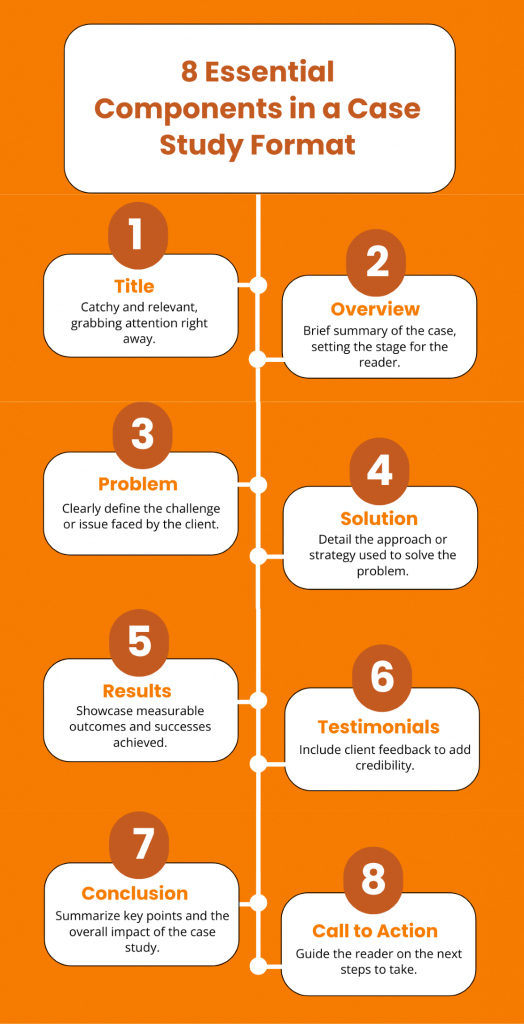
Case studies format helps you to plan and write the case study for your clients. With this outline in mind, you can create steps to complete the process of writing and publishing your case study research. There are eight components of a case study that are essential for building a layout of information in the correct order that makes sense to the viewers.
Start with a catchy “Title” that grabs attention and an “Overview” that sets the stage. Clearly define the “Problem” your client faced, and then showcase your “Solution” in detail. Highlight the success with “Results” that are measurable and impactful. Add authenticity with “Testimonials and Quotes” from satisfied clients. Wrap it up with a firm “Conclusion” and a compelling “Call to Action” in the “About Us” section that guides the reader on what to do next.
By following this format, you create a case study design that resonates with your audience and effectively showcases your brand’s value.
Check out the marketing case study template I’ve included below—it has a clear outline that makes it easy to see how sticking to a format can help you plan and write the entire thing.
How to Plan a Case Study
Now comes the big part! Understanding what to include in a case study outline is just the starting point for beginners. The real challenge lies in creating a step-by-step plan to craft that outline and filling it in with the right information!

1. Set Clear Goals for Your Case Study
Before diving into how to write a case study, defining your ultimate objective is essential. Think about it—what do you want your audience to take away from this case study? For example, your goal is to showcase how your SEO strategies boosted a client’s organic traffic by 150% in just six months. This clear goal will shape your entire narrative and ensure that your case study is laser-focused on demonstrating your expertise and the value you bring.
2. Select a Client that Highlights Your Strongest Suit
Choosing the right client or subject is vital while creating case studies. Imagine you’ve worked with a small e-commerce brand struggling to rank for competitive keywords. Your strategies helped them rank on the first page and increase conversions. This is the perfect client for your case study because their success story directly showcases your SEO prowess.
By picking a client whose experience aligns with your goals, you’ll create a case study that resonates with your target audience.
3. Reach Out to Your Client for Collaboration
Now that you’ve identified the ideal client, it’s time to reach out. Let’s say you contact your client and explain how a case study can highlight their remarkable success story. It’s a great way to spotlight a mutual collaboration based on credibility. Their buy-in is crucial; their insights and data will authenticate your case study.
4. Gather Comprehensive Data and Insights
Data is the lifeblood of any compelling case study. For instance, in your SEO case study, you’ll need to gather data on key metrics like keyword rankings, organic traffic, and conversion rates before and after implementing your strategies. Let’s say your client saw a 50% increase in organic traffic within three months of optimizing their website. Collecting this data will help you build a robust, evidence-based narrative highlighting your impact. However, when dealing with such a large amount of information it’s crucial to use tools to label data to ensure the accuracy and reliability of your data analysis.
It’s essential to monitor the before-and-after data to track the effectiveness of implementing your strategies.
5. Prepare Insightful Questions and Conduct Interviews
It would be best to ask the right questions to get the most out of your client interviews. Imagine asking your client, “What specific challenges were you facing with your organic search rankings before we started working together?” or “How did our SEO strategies help you achieve your business goals?” These questions will lead to detailed responses that add depth to your case study, making it more than just numbers on a page.
Always ask questions that uncover the key challenges your clients face. This way, your prospects will know when to turn to you to navigate or overcome similar obstacles in their business.
Since I’m giving an example of an SEO case study in marketing, you can try these questions to interview your existing client. Obviously, you can modify the sentences according to your industry basics, but these types of questions are fundamental for collecting structured data from your clients.
- What were your business’s main SEO challenges before we started working together?
- Can you describe your initial expectations for implementing our SEO strategies?
- What specific SEO tactics did we implement that you found most effective?
- How did you monitor and measure the impact of these strategies on your organic traffic?
- What were the key metrics or results that stood out to you after the first three months?
6. Ask Questions That Drive the Story Forward
Impactful questions are the backbone of a strong case study. They allow you to highlight the unique value you delivered to your clients. You can effortlessly showcase your USPs within the case study by asking the right questions.
Focus on inquiring about the effectiveness of your services and strategies, their impact, and which aspects of the solution were most beneficial. This insight will be your key to demonstrating the tangible benefits you offer your clients.
Consider asking questions like:
- Can you share a moment when you first noticed a significant improvement in your website’s organic traffic?
- How did the increase in organic traffic impact other business areas, such as lead generation or sales?
- What feedback did your team or customers receive regarding the changes in your site’s performance?
- Looking back, what do you believe was the most critical factor in achieving these results?
- How has this success with SEO influenced your overall marketing strategy moving forward?
These types of questions encourage clients to share their experiences in a way that paints a vivid picture for your readers, making the case study more relatable and engaging.
7. Draft a Clear and Organized Outline
With all the data and insights gathered, it’s time to create a well-structured case study outline. Let’s say you start with a brief overview of your client’s business and its challenges, followed by a detailed account of the SEO strategies you implemented. Then, you showcase the results with hard data and close with client testimonials and a solid call to action.
As mentioned above, organizing your content in a logical, easy-to-follow format will help you write a case study that not only informs but also captivates your audience.
These steps are the cornerstones of designing a case study. Once you complete this checklist, you can proceed to the next step, which is writing a case study. Since I discussed planning an SEO case study extensively, here is a case study template that perfectly illustrates the process.
How to Write a Case Study
You want to create an informative case study for your prospects. But how do you make sure it’s done right? Here’s a step-by-step guide on how to write a case study that drives results.
1. Craft a Compelling Headline
Your headline is the first thing readers see, so make it count! It should grab attention and hint at the success story you’re about to share.
How to Write a Case Study Title:
1. Highlight the Result: Showcase the critical success, like “Increased Sales by 200%.”
2. Be Clear and Direct: Make sure the headline is straightforward to grasp.
3. Use Action Words: Start with strong verbs like “How We” or “Achieved.”
4. Mention Client or Industry: Include relevant details for specificity.
5. Keep It Short: Make it concise and attention-grabbing.
2. Start with a Strong Introduction
Kick off your case study with a broad overview that sets the stage. Provide the big picture and construct a clear narrative that draws readers in, making them eager to learn more about how you solved a significant challenge.
Look at the consulting case study template, which includes a stunning overview description and precise instructions for writing a short and compelling introduction. You can add every little detail to hook the reader.

Get This Template and More
3. Discuss Specific Challenges of Your Client
This is where your prospect can truly connect. By highlighting unique yet specific challenges to their industry, you give them insight into issues they might not have encountered yet—or ones they’ve already faced. This way, they’ll know exactly who to turn to when similar challenges arise.
The following financial case study template provides a brief flow of the company’s common challenges in the financial analysis process. The template is almost ready to use with this domain-specific content, requiring minimal adjustments to design your case study.
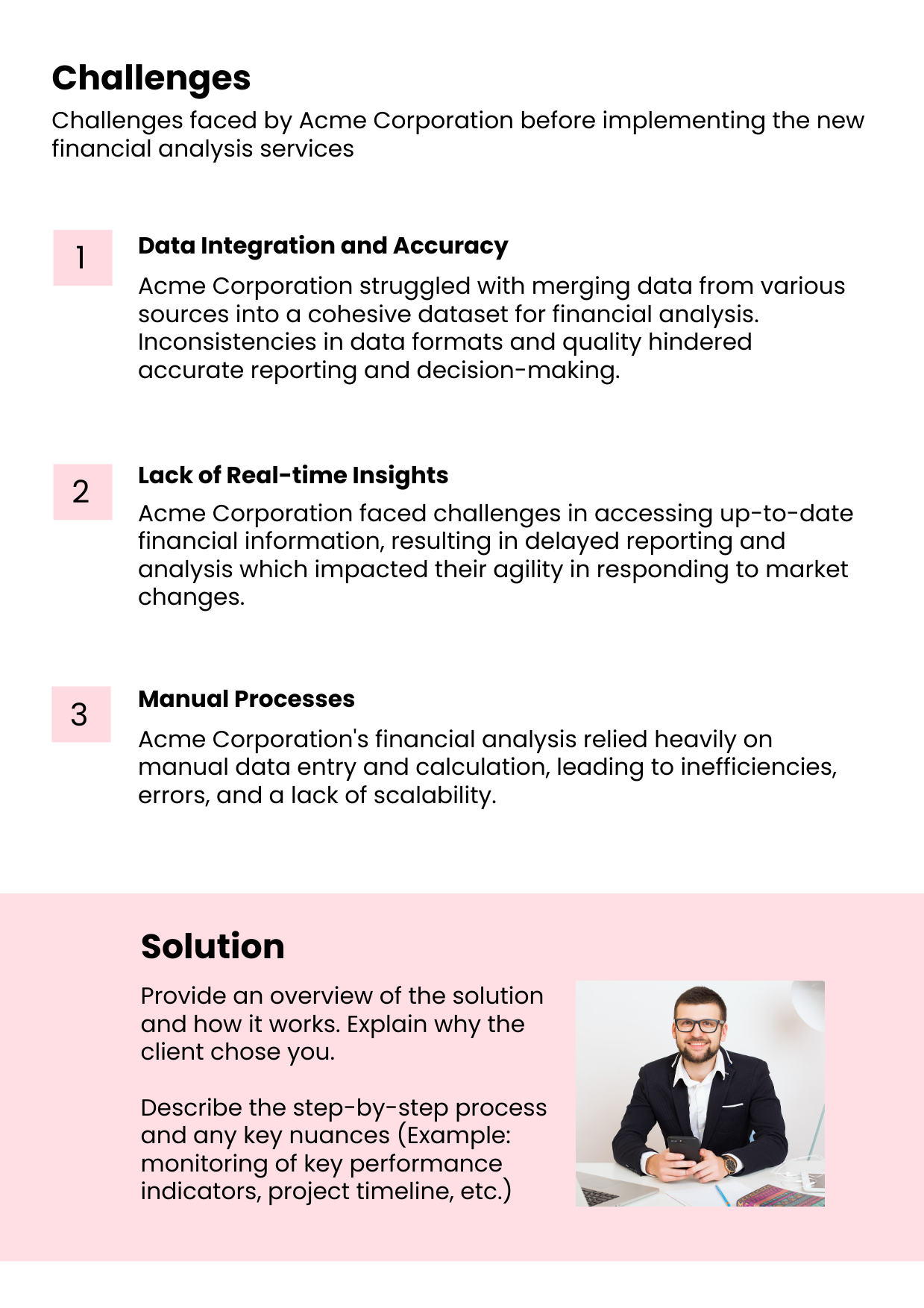
Get This Template and More
4. Highlight the Solution
Now, dive into the heart of the story. Highlight the solution you provided, and make sure to include a notable achievement or key result. This is your chance to shine!
Check out the format for presenting the implications of your service on your client’s business. The benefits should be well-written and data-driven to convince your upcoming clients. This graphic design case study format helps you understand the specific impacts a company seeks from a reputable graphic design firm.
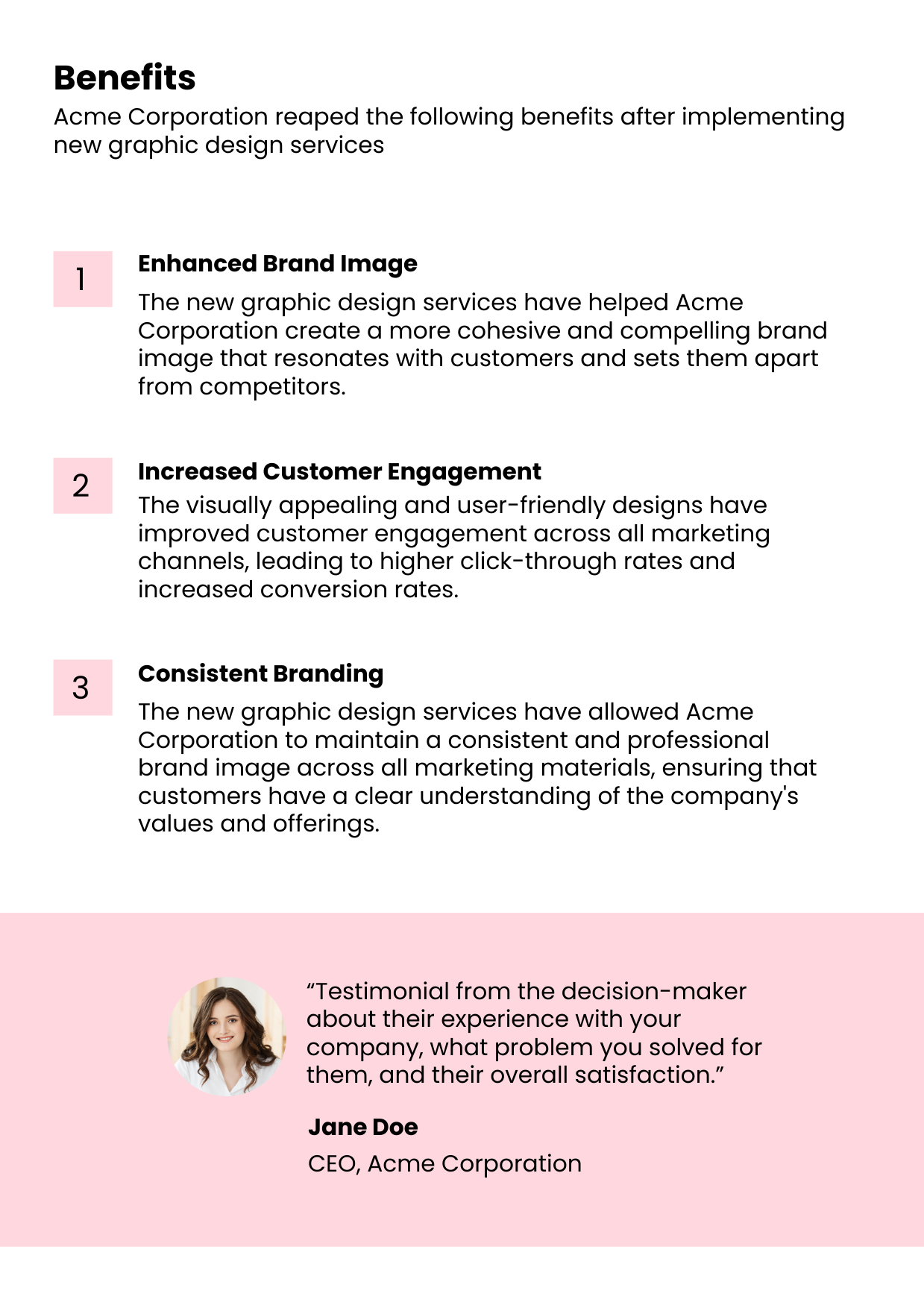
Get This Template and More
5. Present Quantifiable Results
When sharing the outcome, numbers speak louder than words. Present quantifiable results that clearly demonstrate the impact of your solution. Use graphs or charts to make the data easy to digest and visually appealing.
6. Be Clear and Concise
Less is more. Stick to the point and offer just the right amount of detail to keep your readers engaged. Include data that supports your claims, but avoid overwhelming them with too much information.
Here’s a stunning sales consulting case study that uses a simple case study layout and details written in readable, plain language to gauge more utility.

Get This Template and More
7. Treat Your Case Study Like a Story
Focus on your customer’s journey. Think of your case study as a story in which your client is the hero, and your solution is the tool that helped them succeed. This approach will make your case study relatable and compelling.
8. Be as Specific as Possible
Don’t be vague—details matter. Mention the specific company and its industry to let your audience know that the challenge and solution are relevant to them. The more precise you are, the more credible and trustworthy your case study will be.
Check out the sample case study below for payroll accounting. The details are clearly organized and grouped to emphasize the type of case study.

Get This Template and More
Also, the next case study template displays very specific problems that a company faces when it lacks digital marketing expertise.
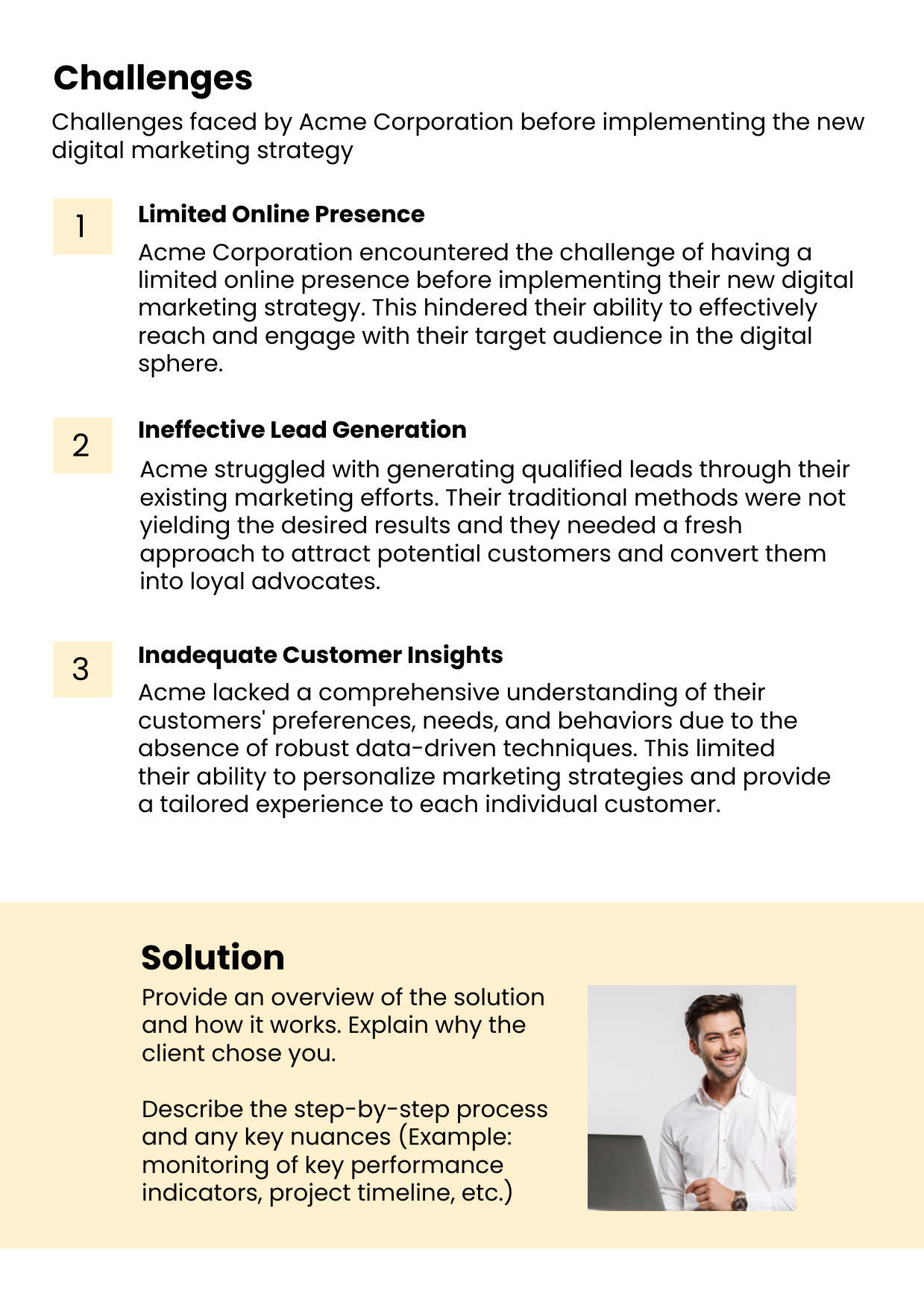
Get This Template and More
These templates make it a breeze to craft a case study that’s perfect for your niche.
9. Use Direct Quotes from the Client
Quotes from your client add authenticity and credibility. They give readers insight into the client’s perspective and make your case study more relatable. Plus, a glowing testimonial is always a nice touch!
The following inbound marketing case study has a prominent client testimonial. With the brief instructions on this template, it’s easier for you to understand how to capture the golden words of your client and use them as a word-of-mouth strategy within the case study.
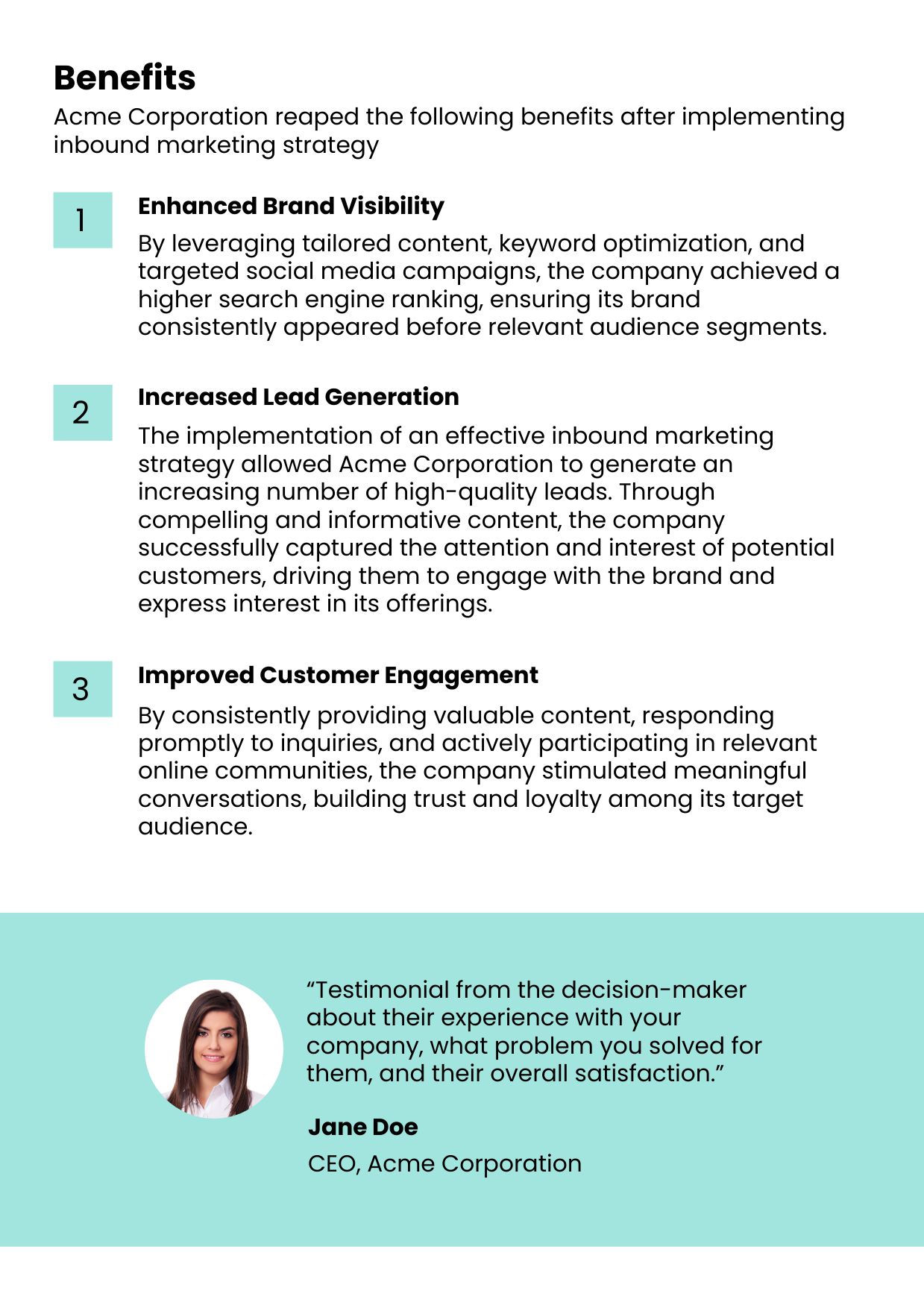
Get This Template and More
10. Pick an Interesting Angle
Find a unique angle that makes your case study stand out. Maybe it’s an unexpected challenge you overcame, or perhaps it’s a particularly innovative solution. Whatever it is, make it intriguing.
11. Make the Key Takeaway Crystal Clear
Your readers should walk away with a clear understanding of the main point of your case study. This takeaway should reinforce your expertise and the value of your solution.
12. Include a Call to Action (CTA)
Don’t leave your readers hanging—tell them what to do next! Include a compelling summary about your company, showcase your happy client base, and conclude the journey with a strong CTA, whether to contact you for a consultation, download a related resource, or learn more about your services on social media, like the following case study template design.
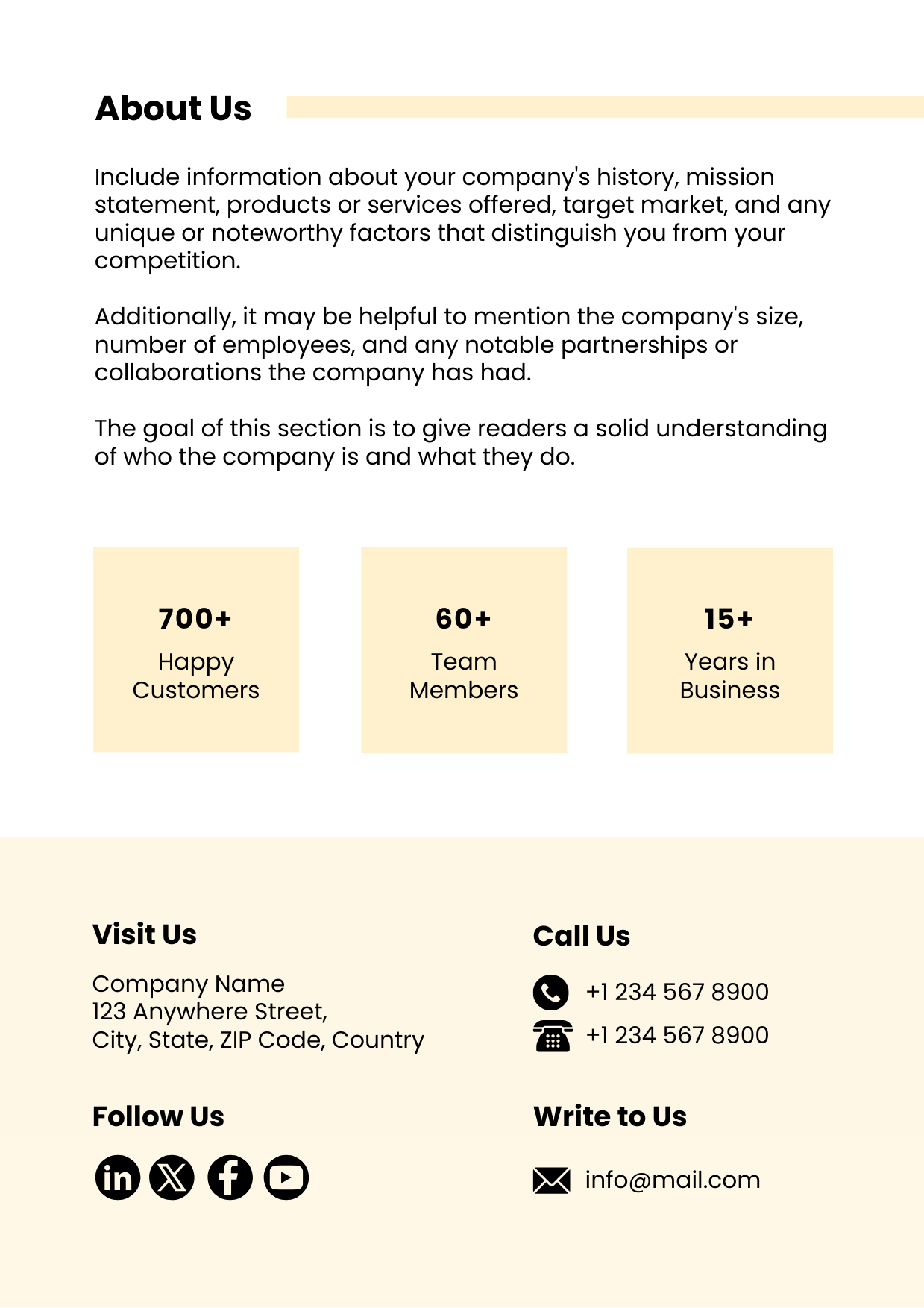
Get This Template and More
12. Format Professionally
The design of the case study is just as important as the content. A well-formatted, visually appealing document makes a great impression and enhances readability. With ready-to-use niche-oriented templates, you can easily create a professional-looking case study that impresses and converts. Here is an eye-catching template for an AI assistant software case study that displays a sleek and well-navigated format.

Get This Template and More
13. Make It Readable
Easy readability is key. Use simple language, short paragraphs, and bullet points where appropriate. Your case study should be easy to scan and digest. Follow the thirteen design principles to create a standout piece that enhances your marketing efforts.
To understand this, take a look at the following consulting case study template.

Get This Template and More
14. Finalize and Proofread Your Case Study
In order to excel in how to write case studies, give your case study a final review before you hit publish. Proofread carefully to catch any typos or errors, and make sure everything flows smoothly. A polished case study reflects your attention to detail and professionalism.
How to Summarize a Case Study
To effectively summarize a case study, start by completing all sections, including the introduction, challenges, solutions, and results. This approach helps marketers identify key points to highlight, making it easier to craft a succinct and engaging summary.
One tricky thing is the length of the case study summary. So, how long should a case study summary be?
The length of a case study summary can vary depending on the details you’re covering. Generally, it should be kept concise, usually spanning a couple of lines or up to a single page with several paragraphs. If you’re crafting a customer case study and want to flex your storytelling muscles, it’s perfectly fine for the summary to stretch to a full page.
If summarizing a case study seems daunting, try DocHipo’s advanced AI Writer tool, which effortlessly creates a crisp and concise summary.
Watch this short video to use it.
How to Cite a Case Study
This is the last step in writing a case study analysis. Citation in a case study is the practice of giving proper credit to the sources you reference or use in your research. It helps validate your work, shows the depth of your research, and avoids plagiarism. Follow the below steps to cite a case study:
- Identify the Source: Gather details like the author, title, publication year, and where the case study was published.
- Choose a Citation Style: Follow the specific formatting style (APA, MLA, Chicago, etc.) required for your work.
- Format the Citation: Arrange the details according to the chosen citation style.
- Include In-Text Citations: Place citations within the text or paragraphs for the case study.
- Create a References List: At the end of your case study, compile all your sources in a bibliography or reference list.
For case studies, citations in APA and MLA styles are very common. If you are just beginning, then you might be confused about these case study citation formats.
Hence, take a look at the picture below, which easily comprehends the APA vs MLA citation features.
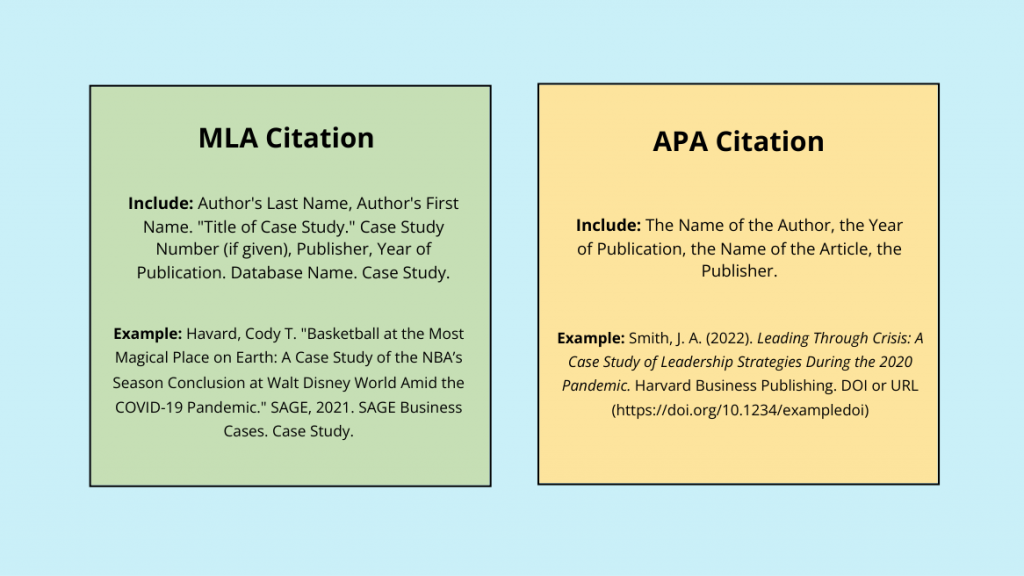
Still feeling overwhelmed about case studies? Be stress-free with the most convenient case study maker, which saves time and allows you to present data in the most attention-grabbing way.
Watch the video to create case studies in minutes with DocHipo’s case study maker.
Conclusion
To summarize, if you want to write a case study, start with a proper case study format, plan the case study, and finally write it with all the information in hand. Then, write a summary to provide an overview of your case study, and finally, add citations for reference.
Meanwhile, if you want to design a case study, Try DocHipo templates. Sign up to explore all the case study templates.
FAQs
What is the structure of a case study?
A case study typically includes the following sections: Title, Introduction, Background, Problem Statement, Solutions, Results, and Conclusion. Each section serves to tell a comprehensive story of the business, from the issue at hand to the resolution and outcomes.
What are the 5 essential elements of a great case study?
The 5 essential elements are: 1) Clear Objective, 2) Detailed Background, 3) Specific Challenges, 4) Effective Solutions, and 5) Measurable Results. These components provide a compelling narrative that highlights the value delivered.
How to begin a case study?
Start a case study by defining the purpose and scope of the study. Introduce the subject, outline the problem, and provide background information to give readers context. This sets the stage for the detailed analysis that follows.
How to make an introduction in case study?
To craft a compelling introduction, briefly describe the subject, outline the problem they faced, and explain why the study is relevant. This section should grab the reader’s attention and make them interested in the rest of the study.
How to make a business case study?
A business case study should begin with a clear objective and background information. Identify the problem, explain the solutions implemented, and conclude with the results achieved. Use real data and quotes from stakeholders to enhance credibility.
How to write a case study step by step?
To write a case study step by step, start by identifying the case you want to explore and gathering relevant data on the subject. Outline the structure of your case study, then craft an engaging Introduction to set the context. Next, detail the Background and Challenges faced, followed by the Solutions applied. Share the Results and Conclusion to highlight the impact. Finally, edit and proofread your case study to ensure clarity and accuracy.


